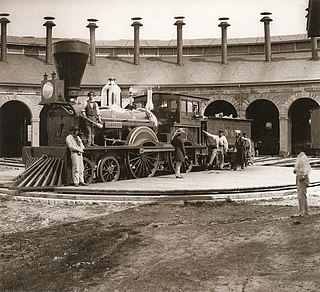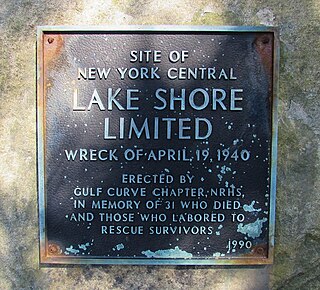Related Research Articles

The Red Line is a rapid transit line operated by the Massachusetts Bay Transportation Authority (MBTA) as part of the MBTA subway system. The line runs south and east underground from Alewife station in North Cambridge through Somerville and Cambridge, surfacing to cross the Longfellow Bridge then returning to tunnels under Downtown Boston. It continues underground through South Boston, splitting into two branches on the surface at JFK/UMass station. The Ashmont branch runs southwest through Dorchester to Ashmont station, where the connecting light rail Ashmont–Mattapan High Speed Line continues to Mattapan station. The Braintree branch runs southeast through Quincy and Braintree to Braintree station.

On March 15, 1999, Amtrak's southbound City of New Orleans passenger train collided with a semi-trailer truck in the village of Bourbonnais, Illinois, United States. Most of the train derailed, killing eleven people. A National Transportation Safety Board (NTSB) investigation into the accident attributed the cause to the truck driver trying to beat the train across a grade crossing. The NTSB's recommendations from the accident included increased enforcement of grade crossing signals, the installation of train event recorders at all new or improved grade crossings, and procedures to provide emergency responders with accurate lists of all crew members and passengers aboard trains. The city of Bourbonnais erected a memorial near the site to commemorate those killed in the accident.

The Great East Thompson Train Wreck was a large rail disaster which occurred in East Thompson, Connecticut, on December 4, 1891. It was one of the most extensive train wrecks in American history, and the first of two to involve four trains. It happened on the New York and New England Railroad, which provided a shortcut from New York City to Boston by making a diagonal across Connecticut. The railroad is now abandoned, and most of its tracks removed.

The Great Western Railway was a railway that operated in Canada West, today's province of Ontario, Canada. It was the first railway chartered in the province, receiving its original charter as the London and Gore Railroad on March 6, 1834, before receiving its final name when it was rechartered in 1845.
The Federal Express was an overnight named passenger train run by the Pennsylvania Railroad and the New York, New Haven and Hartford Railroad between Washington, DC's Union Station and Boston, Massachusetts's South Station from 1912 to 1971. At different times, its route has taken it across the Hudson River via a car float between Port Morris and Jersey City, the Poughkeepsie Bridge, and finally the Pennsylvania Tunnel and Terminal Railroad. The final routing was identical to today's high-speed Northeast Corridor.

North Quincy station is an MBTA subway Red Line station in Quincy, Massachusetts. It is located in North Quincy, off Hancock Street. A major park-and-ride stop, it has over 1200 parking spaces for commuters. The station is fully accessible.

Wollaston station is a rapid transit station in Quincy, Massachusetts. Located in the Wollaston neighborhood, it serves the MBTA's Red Line. It was opened in September 1971 as the second of three stations in the original South Shore Extension, replacing a mainline rail station which had been located there from 1845 to 1959. Wollaston station was closed from January 8, 2018, to August 16, 2019, for renovations to the station, including flood mitigation and accessibility improvements.

The Norwalk rail accident occurred on May 6, 1853, in Norwalk, Connecticut, and was the first major U.S. railroad bridge disaster; 48 were killed when a train travelling at 50 miles per hour (80 km/h) plunged into the Norwalk Harbor off of an open swing bridge.

The Rockport train wreck occurred in Rockport in Mansfield Township, New Jersey, United States, about three miles outside of Hackettstown, on June 16, 1925. A violent storm washed debris onto a grade crossing, derailing a Lackawanna Railroad (DL&W) train. The crash killed 42 passengers and five crewmen and injured twenty-three others.
The Jeannette's Creek train wreck, also known as the Baptiste Creek train wreck, was a fatal railroad accident on October 27, 1854, at Baptiste Creek near present-day Jeannettes Creek in Chatham-Kent, Ontario. It was Canada's first major train wreck, leaving 52 people dead and indeed the worst rail disaster in North America at that time.
The Indianola Train Wreck was a railway accident that occurred at 7:08 a.m. on May 29, 1911, on the Chicago, Burlington and Quincy Railroad one half mile west of Indianola, Nebraska leaving 18 dead and 32 injured.

The 1953 Pennsylvania Railroad train wreck occurred on January 15, 1953, when a passenger and mail train from Boston to Washington DC failed to brake sufficiently on its approach to Union Station, Washington, jumping the platform and plunging through the floor of the concourse. There were no deaths, but 43 people were injured.

A train crash with fatalities occurred shortly after 11:30 p.m. on April 19, 1940, when a first-class westbound Lake Shore Limited operated by the New York Central Railroad, derailed near Little Falls, New York, United States. The accident was later found to have occurred due to excessive speed on the Gulf Curve, the sharpest on the Central's lines. It killed 31; an additional 51 were injured.

The Baker Bridge train wreck occurred on November 26, 1905, in Lincoln, Massachusetts, when two passenger trains on the Fitchburg line of the Boston and Maine Railroad were involved in a rear-end collision. Seventeen people were killed in the wreck. Engineer Horace W. Lyons was charged with manslaughter; however, a grand jury chose not to indict him.
The Wollaston disaster was a railroad accident that occurred on October 8, 1878, in the Wollaston neighborhood of Quincy, Massachusetts. 19 people were killed and 170 were injured when an incorrectly placed switch caused the derailment of an excursion train returning from a sporting event. The conductor who placed the switch was convicted of manslaughter, but the conviction was overturned on appeal.

The Cedar train wreck occurred on the night of January 23, 1956, when the Norfolk and Western (N&W) Pocahontas passenger train derailed at more than 50 mph (80 km/h) along the Tug River near Cedar, West Virginia. The accident killed the engineer and injured 51 passengers and nine crew members. It was the last major wreck of a steam-powered revenue passenger train in the United States.

On the evening of January 13, 1882, a southbound New York Central passenger train crashed into the rear of another one stopped on the tracks along Spuyten Duyvil Creek in the similarly named neighborhood of the New York City borough of The Bronx. Eight people were killed, and 19 seriously injured, by the crash and fires afterwards, fires that neighborhood residents and crew extinguished by rolling large snowballs into them until local firefighters arrived. Among the dead was State Senator Webster Wagner, inventor of the sleeping cars used on the train, between two of which he was crushed to death, and a newlywed couple who died together after the bride refused to allow a rescuer to cut her clothing so she could escape. It was the deadliest rail accident in New York City at that time, remaining so for another 20 years.
References
- 1 2 3 "Wreck on the Old Colony". The New York Times. August 20, 1890.
- 1 2 3 "16 Dead: Wollaston Disaster Repeated". The Boston Daily Globe. August 20, 1890.
- 1 2 3 4 5 Massachusetts Board of Railroad Commissioners (1890). Annual Report of the Board of Railroad Commissioners 1890. pp. 113–135. Retrieved 18 February 2022.
- 1 2 "The Old Colony Disaster". Engineering News. August 30, 1890.
- ↑ "Funeral of E. C. Bailey". The Boston Daily Globe. August 24, 1890.
- ↑ "Welch in Jail: Boss of Section Gang Arrested. Held Responsible for Quincy Wreck". The Boston Daily Globe. September 1, 1890.
- ↑ "Second Degree: J. F. Welch Indicted for Manslaughter". The Boston Daily Globe. September 6, 1890.
- ↑ "Quincy Horror Recalled: Trial of Joseph F. Welch for Manslaughter". The Boston Daily Globe. April 29, 1891.
- ↑ "Charges Not Proven: No Verdict in Welch Man slaughter Case". The Boston Daily Globe. May 2, 1891.